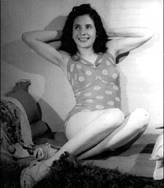Eva Perón Time-Line (6/26/14)
Doña María Eva Duarte de Perón
- May 7, 1919. Born in Los Toldos (also known as General Viamonte)—some 150 miles west of Buenos Aires. Population of 15,000. Illegitimate daughter (along with 4 other siblings) of Juan Duarte and Juana Ibarguren . Her father was a wealthy rancher with a wife and family in nearby Chivilcoy. He abandoned Evita’s family in 1922—leaving Juana and her children in poverty.
- 1930. Evita’s family moved to nearby Junin, where Evita had her first opportunity to “perform”—reading poetry and participating in local theatrical troupes.
- 1935. Evita (at the age of 15) moved to Buenos Aires to become an actress.

- Early-1940s. Her first break occurred when a radio company hired her in a daily role in one of their shows (sponsored by a soap company—hence, a “soap opera”). Shortly, she signed a lucrative contract for playing “Great Women of History” (an omen?) on a popular radio drama. She was very well-compensated financially, and moved into a comfortable apartment in the respected neighborhood of Recoleta (where she is currently interred in the Recoleta Cemetary, along with many other Argentine dignitaries).
- January 22, 1944. Evita meets Juan Peron (the Labor Minister at that time) at an art gala that Peron had sponsored to aid earthquake victims. The two left the gala around 2 in the morning. They were soon living together. He was 48. She was 24. Peron soon included Eva in his meetings with his advisors.
- May, 1944. Broadcast performers are required to organize a union. Evita was elected President of the union.
- October 9, 1945. Juan Peron was arrested by his opponents who feared his growing political power and his overwhelming support from the descamisados.
- October 17. 1945. Around 300,000 supporters gathered before the Casa Rosada to demand Peron’s release. At 11pm, Eva Peron addressed the crowd from the balcony. Some historians describe this as one of the most powerful moments in modern Argentine history. Though Eva has been credited in some popular circles as having organized the demonstration, the Peronist unions were responsibility for the protest. The Partido Justicialista (current name of the Peronist party) still celebrates October 17 as “Loyalty Day.”
- October 23, 1945. Evita and Juan Peron are married in a civil ceremony.
- 1946. Eva campaigns with Juan Peron in his successful presidential bid (with an 11% margin of victory over the Radical Party)—which pitted the old, oligarchic order with the populism of Peron.
- 1947. Evita begins her widely publicized “Rainbow Tour” of Europe. She will meet the Spanish dictator Francisco Franco and the Pope—among other European dignitaries. Franco had invited Juan Peron, but it was decided that Evita would initiate this European tour in his place. Allegedly, the Peron’s did not want to be too closely tied to Franco—thus Evita conducted a “good-will” tour of all of Europe. Some in the Argentine opposition to Peron speculated that the purpose of the tour was to deposit funds into a Swiss bank account. Historians discount this notion. Evita was featured in a cover story for Time magazine for her European tour. After the tour, Evita adopted a much more austere look—from a simple hairdo to conservative business suits designed by Christian Dior.
- July, 1948. In a reaction to her rejection by the elitist women’s charity group, Evita created the Eva Peron Foundation. The Foundation played a very significant role in the rise to national prominence of Evita. Funded by donations, deductions from salaries of unionized workers, and other taxes, the Foundation acquired assets of over 200 million 1948 dollars and employed over 14,000. It distributed shoes and cooking pots—provided scholarships—and built homes and hospitals. The charitable institution even built communities. Best known is Evita City, which still exists with 70,000 residents about 13 miles from the heart of Buenos Aires.
- 1951. Women are granted the right to vote. Evita, at least symbolically, claimed it as a personal accomplishment and created the Peronist Women’s Party.
- 1951 Presidential Election. Evita had ambitions to be the vice-presidential candidate on the ticket with her husband. However, the military could not accept the possibility of her acceding to the presidency.
- August 22, 1951. Peronist unions hold a rally of two million on the Avenida 9 de Julio (only a few blocks east of the Casa Rosada) demanding that Evita announce her candidacy for the vice presidency. However, Evita shortly discloses( in her declaration labeled “The Renouncement) that she will not run (interpreted as either a magnanimous gesture or bending to pressure of the military and the oligarchy). Additionally, her health was failing. Juan Peron hid the truth from his wife, who had developed an advanced stage of cervical cancer.
- June 4, 1952. Evita rode with Juan Peron in a Buenos Aires parade celebrating his re-election as President. She was so ill, she could not stand on her own.
- July 26, 1952. Eva Peron succumbs to the cancer and dies at the age of 33. Her remains were embalmed, in preparation for possible public display later. The plan was for her body to be viewed at the bottom of a huge statute of a descamisado. However, Peron was overthrown in a military coup in 1955 before the monument was completed. The military government removed her body from display, and the location of the remains was a mystery for the next 16 years.
- 1971. The military reveals that the body was buried in Milan, Italy under a false name. The remains were flown to Spain where Juan Peron and his third wife (Isabel) kept it in their dining room.
- Mid-1970s. The military steps aside and allows Juan Peron to return from exile in Spain and be elected as President once more. He dies in office in 1974 and is succeeded by Isabel. Isabel had Evita’s body returned to Argentina, briefly displayed beside that of Juan Peron, and than securely buried in the Duarte family tomb in The Recoleta Cemetery, Buenos Aires.
- Also see:
|



